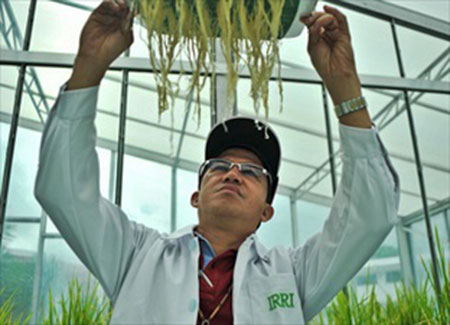|

by Heather Callaghan
August 29, 2013
from
NaturalBlaze Website

Genetic modification is touted as the only way to feed starving
nations, yet they often have decreased yields or lead to superweed
and insect resistance.
But there are solutions other than changing the entire ecology.
Biodiversity, crop rotation techniques, or... simple
crossbreeding!
Earlier in August, a study published in Nature Genetics showed
promising results by Japanese researchers headed by Yusaku Uga,
researcher with the National Institute of Agrobiological Sciences in
Japan.
Rice is heavily studied now - it is a large part of nearly half of
the world's daily diet. However, it doesn't do well at all in
drought conditions, mainly because of its shallow root system.
A Deeper Rooting 1 (DRO1)
gene found in 60 rice varieties - and when its roots were pointed
down instead of sideways - created roots twice as deep as usual.
This could allow it to adapt to drought by reaching more water and
nutrients in the soil. The results of what they did with those
findings were amazing.
They found that in moderate droughts, the DRO1 rice yield was double
of typical shallow-rooted rice. But in severe drought it became even
greater with 3.6 times more yield.
Uga had said:
The most important point is that we
had rice grains produced under drought conditions. When rice
crops just tolerate drought, they cannot get water and
nutrients, resulting in a kind of survival mode.
They crossbred one type of rice that
contained DRO1 with a more typical shallow root variety and then
bred those offspring to make a crop where the DRO1 gene was
forefront.
Crossbreeding, which has gone on for centuries, is not
anywhere near the same thing as
genetic modification, as
companies like Monsanto want people
to believe.
International Rice Research Institute (IRRI)
thinks that 8-10 million extra tons of rice are needed annually to
keep prices at an affordable $300 per ton. Drought affects India
greatly among other countries.
However, it should be noted, that IRRI is backed
by Gates and
Rockefeller Foundations and they
are forcefully pushing GM field trials with Golden Rice,
especially in the Philippines, with the "best of intentions."
Even though the poor, the hungry, and
the farmers it was designed for responded by trampling and uprooting
the trial.
Another type of GM rice trial is going on in China. And during that
trial, researchers discovered that the
GM glyphosate-resistant breed
designed to thwart invasive weedy rice counterparts, actually
bestows its transgenic material on them through cross-pollination,
making them an even stronger threat.
Without changing the ecology, simple crossbreeding techniques can
often innovate adaptable varieties to create stronger yields during
drought; thereby feeding more, bolstering the economy, and negating
millions in research for GM breeds that could be hazardous to human,
animal, and environmental health or create more farming troubles.
Sources
Rice Gene
...Digs
Deep to Triple Yields in Drought
by Science and Development
Network
August 6, 2013
from
AsianScientist Website
Japanese researchers have identified
a gene that triples the yield of rice during
droughts
by giving rice plants deeper roots.
A gene that gives rice plants deeper
roots can triple yields during droughts, according to Japanese
researchers writing in Nature Genetics this week (4 August).
Rice is a staple food for nearly half of the world’s population, but
is also particularly susceptible to drought owing to its shallow
roots, researchers say.
The new study shows that by pointing roots down instead of sideways,
the Deeper Rooting 1 (DRO1) gene results in roots that are nearly
twice as deep as those of standard rice varieties.
“If rice adapts to or avoids drought
conditions using deeper roots, it can get water and nutrients
from the deep soil layers,” says the study’s lead author Yusaku
Uga, a researcher with Japan’s National Institute of
Agrobiological Sciences.
Yusaku Uga and his team found
that in moderate drought conditions, the yield of rice with DRO1 was
double that of the shallow-rooted rice variety.
Under severe drought conditions, this
increased to 3.6 times greater.
“The most important point is that we
had rice grains produced under drought conditions,” says Uga.
“When rice crops just tolerate drought, they cannot get water
and nutrients, resulting in a kind of survival mode.”
The DRO1 gene occurs naturally in more
than 60 rice varieties. For the study, the research team crossbred a
rice variety carrying DRO1 with a shallow-rooted variety and then
bred the offspring together to produce a rice crop in which DRO1 was
uniformly present.
The International Rice Research Institute (IRRI) estimates
that an additional 8-10 million tonnes of rice will be needed each
year to keep rice prices affordable at around US$300 per tonne.
Finding a drought-resistant variety of
rice may be key to attaining this goal, according to researchers.
“Drought is the most widespread and
damaging of all environmental stresses,” says Sophie Clayton,
head of communications at IRRI.
“In some states in India, severe drought can cause as much as 40
per cent yield loss [in rice crops]. Moreover, with the onset of
climate change, droughts may become more frequent and more
severe.”
The article can be found at: Uga et al.
(2013)
Control of Root System Architecture by DEEPER
ROOTING-1 Increases Rice Yield Under Drought Conditions.
|

